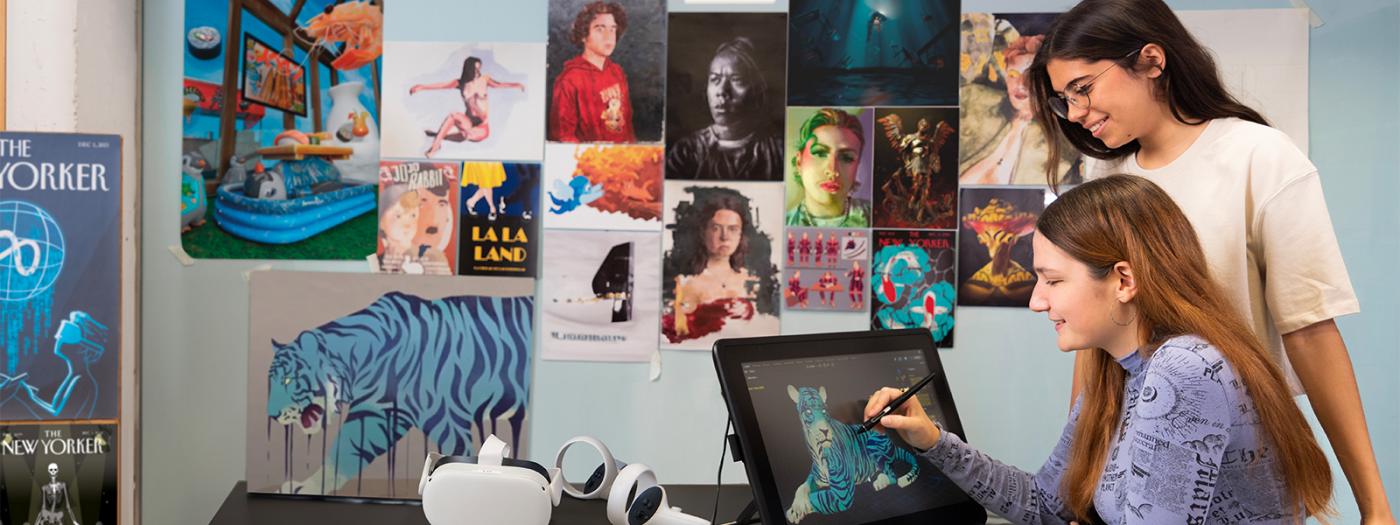Titular Professors
Learning Outcomes of this subject are:
RA 156 The student will be able to establish an artistic vision in the development of a project.
RA 157 The student will be able the manage multidisciplinary teams during the development of a creative project.
1 Intro ? References constellation
2 Steal like an artist
3 Break ? work on brief 1
4 Break ? complete brief 1
5 Everything is a remix part 1 & 2
6 Everything is a remix part 3
7 Typography and lettering
8 How to get it done: agile and pomodoro technique
9 Art Direction in Advertising & Brand Design
10 The relationship between copywriting and art
direction.
11 Digital Media and Interactive Art Direction
12 The role of UI/UX in visual storytelling.
Immersive media (VR, XR, AR)
13 Testing, proofreading. how to pitch like a pro
14 Work on brief
14 Project week
15 Project week
16 Formative Assessment
17 Formative Assessment
18 Cinematic Art Direction: Film & Video
19 Storyboarding & work on brief
20 Collaborative Processes in Art Direction
21 Work on Brief
22 Ethical and Cultural Considerations in Art Direction
23 Work on Brief
24 AI ? opportunities, new workflows and challenges
25 Work on brief
26 AI well done, and sustainable creative processes
(artists working with AI)
27 Work on brief
28 Review
29 Summative assessment
n this subject you will work through different teaching methodologies. There will be a lecture in which the teacher will
introduce concepts about Art Direction and its application tools, as well as examples and references. To establish these
concepts and practices, the students will apply them progressively during the course in their Art Direction project. At
the end of the course, the student will present his/her project in front of a panel, which will evaluate his/her knowledge
of Art Direction from the point of view of a creative team.
MD 1: Master Class with the support of audiovisual material.
MD 2: Seminar.
MD 3: Flipped classroom.
MD 4: Project-based learning
Brief#1: Spiderverse Guerrilla Marketing Campaign ? 10% (Moderately important academic activity)
- Research & Reference Analysis (20%):
Depth of research and how effectively you integrate the style and techniques of your chosen comic artist into
your work.
- Creativity & Originality (20%):
The originality of your Spiderman design and the innovative use of your chosen medium.
- Process & Development (20%):
Clear documentation of your design process, showing how you applied research and developed your ideas.
- Final Design Quality (20%):
The execution, craftsmanship, and attention to detail in your final Spiderman character.
- Guerrilla Placement & Visual Storytelling (20%):
The narrative impact and relevance of placing your Spiderman in a real-world location.
Brief#2: Masterclass: Film directors to learn from ? 10% (Moderately important academic activity)
- Research Depth (25%):
The variety and reliability of the sources you use, beyond just the podcast.
How effectively you explain the director?s references and influences.
- Analytical Insight (25%):
How well you analyse the director?s style, themes, and contributions to film history.
The depth of your understanding of their narrative and visual language.
- Presentation Quality (25%):
The clarity, organization, and design of your slides.
How engaging and coherent your delivery is, including how you adapt the content for the audience.
- Teamwork & Participation (25%):
Collaboration within pairs, ensuring both members contribute equally.
Public speaking skills, with everyone playing a role during the presentation.
Brief#3: Everything is a remix ? 40% (Highly important academic activity)
- To understand and respond appropriately to the requirements of a brief in the field of the creative and cultural
industries. (10%)
- Demonstrate research skills, analysis and execution techniques to establish the art direction of a project. (20%)
- To conceptualize, design, and produce the art direction of a project. (50%)
- Professionalism: to learn how to collaborate, provide constructive feedback, and present a project. (20%)
Brief#4: The Mixtape ? 40% (Highly important academic activity)
- To understand and respond appropriately to the requirements of a brief in the field of the creative and cultural
industries. (10%)
- Demonstrate research skills, analysis and execution techniques to establish the art direction of a project. (20%)
- To conceptualize, design, and produce the art direction of a project. (50%)
- Professionalism: to learn how to collaborate and present a project. (20%)
Ordinary Assessment:
The student must submit all projects and achieve an average grade of 5 out of 10 to pass the course.
Extraordinary assessment:
The student who does not passthe regular assessment hasthe option to passthe course in the extraordinary assessment
session.
Evaluation criteria for all assessment sessions:
If the student's exams, exercises, or assignments do not demonstrate correct written expression, grammar, and spelling,
the maximum grade will be a 4.
If the conditions to pass the session are not met, the maximum grade will be a 4.
Use of AI tools: If AI tools are used in any activity, a paragraph should be indicated stating what AI was used for and what
indications were used to obtain the results. Failure to do so is a violation of academic honesty policies.
Kleon, A. (2012). Steal like an artist : 10 things nobody told you about being creative. Workman Publishing Company.
Cameron, J. (2010). El Camino del artista : un sendero espiritual hacia la creatividad (6a reimpr.). Troquel.
Schön, D. A. (2016). The reflective practitioner : how professionals think in action. Routledge.
https://doi.org/10.4324/9781315237473
Rizzo, M. (2015). The art direction handbook for film & television (2nd ed.). Focal Press.
https://doi.org/10.4324/9781315770871
Bishop, L. (1998). The Art direction book : [how 28 of the world?s best creatives art direct their advertising] (Repr. of the
1st ed. of 1996). British Design and Art Direction.
Kahneman, D. (2012). Thinking, fast and slow. Penguin Books.
Maeda, J. (2006). Maeda, John. Las Leyes de la simplicidad : diseño, tecnología, negocios, vida. Gedisa
